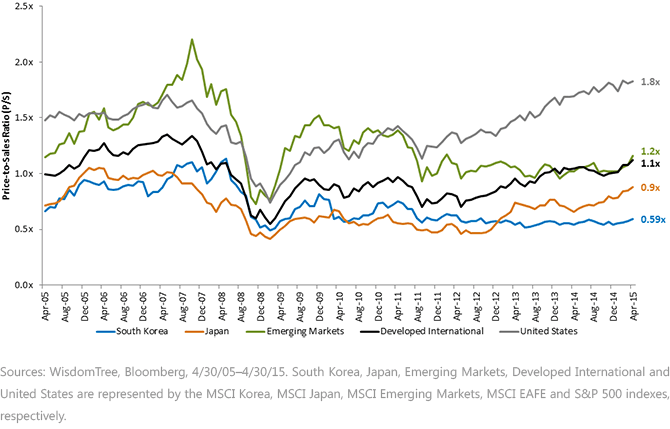South Korea Valuations Close to 2009 Levels


 For definitions of indexes in the chart, please visit our glossary.
Will Government Take Further Action?
One of the most crucial questions when thinking about South Korea is whether the government will undertake more aggressive monetary policy actions to protect the country’s global market share. Although difficult to know with certainty, I think more can be done, and ultimately the probability of the government doing more is higher than of it doing nothing. Therefore, given the relatively low starting valuation, coupled with the potential for the central bank to provide stimulus to the economy, we may be looking at an attractive combination for South Korean equities.
For more research on South Korea, read our Market Insight South Korea at a Crossroads.
1“South Korea says weak yen a challenge,” Reuters, 10/23/14.
2“S. Korea Fires Warning Shot to Japan: We’re Watching Yen-Won,” Bloomberg, 5/3/15.
3Bank of Korea, Monetary Policy Decision, 3/12/15.
For definitions of indexes in the chart, please visit our glossary.
Will Government Take Further Action?
One of the most crucial questions when thinking about South Korea is whether the government will undertake more aggressive monetary policy actions to protect the country’s global market share. Although difficult to know with certainty, I think more can be done, and ultimately the probability of the government doing more is higher than of it doing nothing. Therefore, given the relatively low starting valuation, coupled with the potential for the central bank to provide stimulus to the economy, we may be looking at an attractive combination for South Korean equities.
For more research on South Korea, read our Market Insight South Korea at a Crossroads.
1“South Korea says weak yen a challenge,” Reuters, 10/23/14.
2“S. Korea Fires Warning Shot to Japan: We’re Watching Yen-Won,” Bloomberg, 5/3/15.
3Bank of Korea, Monetary Policy Decision, 3/12/15.Important Risks Related to this Article
Investments focused in South Korea increase the impact of events and developments associated with the region, which can adversely affect performance. WisdomTree and Foreside Fund Services, LLC, are not affiliated with BMO Global Asset Management.

Jeremy Schwartz has served as our Global Chief Investment Officer since November 2021 and leads WisdomTree’s investment strategy team in the construction of WisdomTree’s equity Indexes, quantitative active strategies and multi-asset Model Portfolios. Jeremy joined WisdomTree in May 2005 as a Senior Analyst, adding Deputy Director of Research to his responsibilities in February 2007. He served as Director of Research from October 2008 to October 2018 and as Global Head of Research from November 2018 to November 2021. Before joining WisdomTree, he was a head research assistant for Professor Jeremy Siegel and, in 2022, became his co-author on the sixth edition of the book Stocks for the Long Run. Jeremy is also co-author of the Financial Analysts Journal paper “What Happened to the Original Stocks in the S&P 500?” He received his B.S. in economics from The Wharton School of the University of Pennsylvania and hosts the Wharton Business Radio program Behind the Markets on SiriusXM 132. Jeremy is a member of the CFA Society of Philadelphia.

